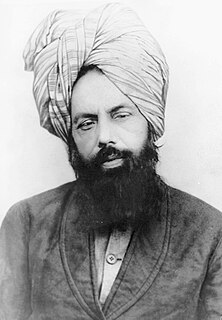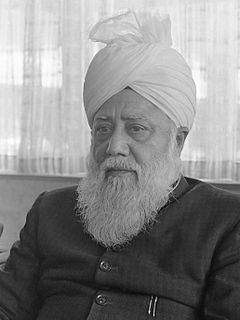
Mirzā Ghulām Ahmad was an Indian religious leader and the founder of the Ahmadiyya movement in Islam. He claimed to have been divinely appointed as the promised Messiah and Mahdi—which is the metaphorical second-coming of Jesus (mathīl-iʿIsā), in fulfillment of Islam's latter day prophecies, as well as the Mujaddid of the 14th Islamic century.

The Lahore Ahmadiyya Movement for the Propagation of Islam, is a separatist group within the Ahmadiyya movement that formed in 1914 as a result of ideological and administrative differences following the demise of Hakim Nur-ud-Din, the first Caliph after Mirza Ghulam Ahmad. Members of the Lahore Ahmadiyya movement are referred to by the majority group as ghayr mubāyi'īn and are also known colloquially as Lahori Ahmadis.

Qadian is a town and a municipal council in Gurdaspur district, north-east of Amritsar, situated 18 kilometres (11 mi) north-east of Batala city in the state of Punjab, India.

Hāfiz Mirza Nasir Ahmad was the third caliph, head of the Ahmadiyya Community. He was elected as the third successor of Mirza Ghulam Ahmad on 8 November 1965, the day after the death of his predecessor and father, Mirza Basheer-ud-Din Mahmood Ahmad.

Mirza Basheer-ud-Din Mahmood Ahmad, was the second caliph, leader of the worldwide Ahmadiyya Muslim Community and the eldest son of Mirza Ghulam Ahmad from his second wife, Nusrat Jahan Begum. He was elected as the second successor of Mirza Ghulam Ahmad on 14 March 1914 at the age of 25, the day after the death of his predecessor Hakim Nur-ud-Din.

Hakeem Noor-ud-Din was a close companion of Mirza Ghulam Ahmad, the founder of the Ahmadiyya Movement, and was chosen as his first successor on 27 May 1908, a day after his death, becoming the first caliph and leader of the worldwide Ahmadiyya Muslim Community. He was a renowned physician, writer, theologian, and an expert in Arabic and Hebrew.

The Fazl mosque also known as The London mosque, is the first purpose-built mosque in London, England. It was opened on 23 October 1926 in Southfields, Wandsworth. At a cost of £6,223, the construction of the place and the purchase of the land on which it stands, was financed by the donations of Muslims with support from the British Muslim convert Khalid Sheldrake. Between 1984 and 2019 the Fazl Mosque was the residence of the caliphs of the Ahmadiyya Muslim Community, and therefore its de facto international headquarters. The administrative headquarters now lies at the site of the Islamabad, Tilford.

Khwaja Kamal-ud-Din was a prominent figure of the early Ahmadiyya movement and the author of numerous works on about Islam.

Malfūzāt is a ten-volume collection comprising the discourses, question-and-answer-sessions, sermons and dialogues of Mirza Ghulam Ahmad, the founder of the Ahmadiyya movement. The volumes contain, for the most part, speech that was transcribed by several of Ghulam Ahmad's close disciples as it was being communicated and was published in Ahmadi periodicals during his lifetime, covering a period starting from 1891 until his death in 1908. This material was compiled and published as a set of volumes during the 1960s.

Ahmadiyya, officially the Ahmadiyya Muslim Community or the Ahmadiyya Muslim Jama'at, is an Islamic revival or messianic movement originating in Punjab, British India, in the late 19th century. It was founded by Mirza Ghulam Ahmad (1835–1908), who claimed to have been divinely appointed as both the Promised Mahdi and Messiah expected by Muslims to appear towards the end times and bring about, by peaceful means, the final triumph of Islam; as well as to embody, in this capacity, the expected eschatological figure of other major religious traditions. Adherents of the Ahmadiyya—a term adopted expressly in reference to Muhammad's alternative name Aḥmad—are known as Ahmadi Muslims or simply Ahmadis.

The Review of Religions is an English-language comparative religious magazine published monthly by the Ahmadiyya Muslim Community. Regularly in print since 1902, it is one of the longest running Islamic periodicals in English. It has been described as the main publication of the Ahmadiyya movement in the language and as a valuable source material for information on the geographical expansion of Ahmadi activity. The magazine was launched by Mirza Ghulam Ahmad with the aim of conveying an accurate understanding of Islamic teachings across the English-speaking world and dispelling misconceptions held against the faith. The articles, however, typically comprise distinctly Ahmadi perspectives. In addition to the English edition published from London, the magazine currently publishes separate quarterly editions in German, French and Spanish.

The timeline of Ahmadiyya history began in 1889 when the Ahmadiyya Muslim Community was established in Qadian, a village of India. It is now a worldwide community consisting of members from over 200 nations.

Ahmadiyya Muslim Community was established in United Kingdom with the pioneering efforts of Chaudhry Fateh Muhammad Sial, who arrived in London in July in 1913. Sial was the first missionary sent overseas by the Ahmadiyya Muslim Community and was under the direction of Hakeem Noor-ud-Din, the first caliph of the movement.

Ahmadiyya is an Islamic branch in the United States. The earliest contact between the American people and the Ahmadiyya movement in Islam was during the lifetime of Mirza Ghulam Ahmad. In 1911, during the era of the First Caliphate of the Community, the Ahmadiyya movement in India began to prepare for its mission to the United States. However, it was not until 1920, during the era of the Second Caliphate, that Mufti Muhammad Sadiq, under the directive of the caliph, would leave England on SS Haverford for the United States. Sadiq established the Ahmadiyya Muslim Community in the United States in 1920. The U.S. Ahmadiyya movement is considered by some historians as one of the precursors to the Civil Rights Movement in America. The Community was the most influential Muslim community in African-American Islam until the 1950s. Today, there are approximately 15,000 to 20,000 American Ahmadi Muslims spread across the country.

Ahmadiyya is an Islamic branch in Spain, under the spiritual leadership of the caliph in London. The earliest history of the Community in Spain dates back to the period of the Second Caliph, when Malik Mohammad Sharid Gujrati, a missionary of the Community, arrived in Madrid on March 10, 1936. However, in the same year the Spanish Civil War broke out forcing Gujrati to abandon the country. Missionary efforts commenced once again following the Second World War, in 1946 when Karam Ilahi Zafar was sent by the caliph. The Basharat Mosque in Pedro Abad, built by the Ahmadiyya in the 1980s is the first mosque to be built in Spain since the Fall of Granada and the end of Muslim rule at the end of the 15th century. Today there are two purpose-built Ahmadi Muslim mosques and roughly 500 adherents in Spain.

Ahmadiyya is an Islamic community in Japan. The history of the Ahmadiyya Muslim Community in Japan begins after a number of mentions by Mirza Ghulam Ahmad, who showed a particular interest in introducing Islam to the Japanese people. The first Ahmadi Muslim missionary to be sent to Japan was Sufi Abdul Qadeer, who was sent by the second Caliph. He arrived in Japan on June 4, 1935. Today there is one purpose-built mosque, the largest in the country, representing an estimated 300 Ahmadi Muslims.

Al-Hajj Abdul Rahim Nayyar was a companion of Mirza Ghulam Ahmad and a missionary of the Ahmadiyya Islamic movement in West Africa. He pledged allegiance to Ghulam Ahmad, formally joining the Ahmadiyya movement, in 1901. Travelling to the Gold Coast in 1921 upon invitation from Muslims in Saltpond, Nayyar was instrumental in consolidating Ahmadiyya missions in several West African countries.

The Ahmadiyya is an Islamic movement in Egypt with origins in the Indian subcontinent. Although the earliest contact between Egyptians and the Ahmadiyya movement was during the lifetime of Mirza Ghulam Ahmad, its founder, the movement in Egypt was formally established in 1922 under the leadership of its second Caliph Opposition to the Ahmadiyya grew particularly in the latter part the 20th century and Ahmadis have seen increased hostility in Egypt more recently. There are up to 50,000 Ahmadi Muslims in Egypt. Although the group is not officially recognised by the state.














